Decorative green shrubs. Types of pruning ornamental shrubs. Trees with a spherical crown
It's time to do some pruning ornamental shrubs. The work is not as simple as it seems at first glance, and requires an understanding of the biology of plants, the characteristics of their growth.
Jasmine (mock orange)
Do not pick up a pruner without a clear understanding of the purpose of the pruning. And the goals are different ...
- Sanitary pruning, or cleaning. We remove all dry, broken, diseased and damaged branches.
- Formative, or structural pruning. Let's look at the bush from the side and imagine the image of the plant, which we will strive for for several years. Having determined the optimal shape of the bush, we remove all unnecessary, cut out intersecting, shading each other or branches growing towards the center.
- Anti-aging, or deep cut. Once every three years, we cut out part of the old branches to the base.
- radical pruning, or "stump landing". Every year in early April, we cut the entire bush into a short stump.
The timing of pruning depends on the type of pruning and the characteristics of the growth of shrubs.
- Early spring. Pruning, which is carried out from the end of frost to bud break, coincides with the natural rhythms of plant life and therefore stimulates the powerful growth of shoots.
- Early summer. After the completion of active sap flow, at the beginning of shoot growth, spring-flowering shrubs and vines are cut.
- Summer pruning. Until August, branches are selectively removed to restrain vegetative growth.
Trimming technique
The cut should be smooth, without damage to the cortex and cambium, which will “tighten” the wound. Thin branches (up to a centimeter in diameter) are removed with a pruner, thicker ones with a garden file or a lopper. Shortening the branches, make a "cut on the kidney."
Slices are immediately covered with garden pitch or sealed with adhesive tape. Sections with a diameter of less than 0.5 cm can be left untreated.
The need for pruning various shrubs
Features of pruning a shrub depend on the characteristics of its growth. Conventionally, shrubs can be divided into several groups.
First cropping group
it blooming in spring and early summer deciduous shrubs. They always form new shoots in the lower part of the bush or in the middle of last year's branches, and flower buds - on last year's growths.
Shrubs of this group are pruned immediately after flowering. Sanitary pruning is applied to them in the spring and maintenance pruning (once every three years) in the spring after flowering, while about half of all old branches are completely removed. If the bush has not been trimmed for a long time, try to rejuvenate it by cutting it almost to the base.
This group includes tall spring-flowering spirea(sharp-toothed, Thunberg, Wangutta, crenate, oak-leaved, nippon, gray, or ashy), forsythia, mock orange (garden jasmine), action, weigela, Japanese kerria, ornamental currant, tree peony and other early flowering shrubs.
Most of them age quickly: noticeably fewer flowers form on old branches, the branches become bare and the bush loses its decorative effect.

Kerria Japanese.
Japanese kerria, often freezing in winter, you can cut it all short, it manages to grow up to a meter in a season and even bloom. The resulting bushes have a neater shape than the old ones falling apart. Particularly interesting are the variegated forms of kerria planted on a stump.

Weigela Red Prince.
Weigel theoretically, it is impossible to prune strongly (it will not bloom). But weigels have a fairly high shoot-forming ability, so frozen plants can be safely cut “under zero”: by autumn they even bloom with a few flowers.

Forsythia European.
forsythia, in which the most flowers are formed on three-year-old branches, they do not touch without urgent need, they only carry out sanitary pruning.
Second trim group
This group includes deciduous shrubs that bloom in mid-summer and autumn, in which flowers form on the shoots of the current year: buddleya, summer-flowering spireas(Japanese, Douglas, white-flowered, loose-leaved), hydrangea paniculata, hydrangea tree, cinquefoil shrub.
To keep the compact, beautiful shape of these shrubs, in early spring last year's annual shoots are radically cut off - into a short stump 10-15 cm high. Thin weak branches are cut to the base. Withered inflorescences are also cut off, but in hydrangeas, inflorescences that retain their decorative effect until the end of the season are not touched.

Hydrangea
Annually pruned Japanese spireas form dense, profusely flowering, bright plants.
This group also includes deciduous shrubs: caryopteris, lavatera, lavender, fragrant rue. The shoots of these plants are woody only in the lower part, and top part usually freezes over in winter.
They are cut not early in the spring, but a little later, when the buds wake up in the lower part of the bush and you can see how much to shorten the stems.
Third cropping group
This group includes deciduous ornamental deciduous shrubs (white derain, different types elderberries).
Deren differs not only beautiful leaves, but also very bright red or cherry bark. But this happens only on young shoots, with age the bark turns gray, the leaves become smaller.
Always bright branches can be achieved only by annual or every two years "landing on a stump", that is, by early spring short pruning (stumps of 10-15 cm are usually left). Do not be afraid to do this: the turf grows over the season.

Almost all species need strong pruning in the spring. elderberry. In addition, elderberry varieties freeze heavily in black winter. Elderberry, after pruning, grows quickly and appears in all its glory of its large carved leaves.
Tamarix and Myricaria also freeze. But they are severely pruned every year even in countries with a mild climate (so as not to stretch). After pruning, the shoots of plants grow by 1-1.5 m and look wonderful, surprising with delicacy.
Fourth trim group
It includes all shrubs that do not form regularly replacing shoots at the base of the bush. Shrubs that produce new shoots only from the apical and upper lateral buds along the periphery of the crown bloom and remain viable even without maintenance pruning. Older branches are not superfluous here - they form the crown.
All types of hawthorn, shadberry, lilac, deciduous euonymus, cotoneaster, viburnum, tannery, decorative varieties cherries, plums and apple trees, bush maples need only sanitary pruning and thinning of the crown.
More than others needs special pruning lilac. Without pruning, flowering becomes scarce, growths and inflorescences become smaller.

Lilac flower buds are located at the tops of last year's growths located in the upper part of the crown, so they cannot be shortened. In a well-developed bush, you can remove part of the shoots from flower buds, leaving the strongest and most well-located, then the remaining inflorescences will be larger. For the same purpose, all weak and inward-growing crowns, intersecting, competing shoots are cut into a ring.
Pruned lilacs in the spring, before the start of sap flow. Before setting the seeds, faded panicles are removed, trying not to damage the nearby shoots with leaves on which new flower buds are laid.
Fifth trim group
This group includes evergreen shrubs and creeping forms (rhododendrons, evergreen species of viburnum and cotoneaster, laurel cherry, dwarf forms of willow and gorse). Due to uniform growth along the perimeter of the crown, they form a strong beautiful bush without pruning. Only diseased or frozen shoots are removed on them in the spring.
Subtleties of cropping
- Branches with long internodes are shortened a few millimeters above the outward bud. This applies to bush maples, hydrangeas, weigels, as well as shrubs with hollow shoots (forsythia, elderberry, some honeysuckle).
- The vitality and splendor of flowering of very many ornamental shrubs is stimulated by pruning, or maintenance, when, by removing old branches, they make room for younger and stronger shoots. Shrubs that have been neglected or have been improperly pruned for years can be put in order with the help of rejuvenating pruning.
- Pay attention to the natural shape of shrubs. It is hardly possible to keep a bush small for a long time or make it grow in an unnatural way without harming the flowering. With maintenance pruning, try to preserve the natural appearance of the plant, and not cut all the branches "one size fits all". Start pruning from the bottom of the bush, moving up. This will save you from double work, as more thin twigs removed at once with a whole branch.
- In most cases, the dying off of old shoots in shrubs is a natural process and should not cause particular concern.
To understand at what interval to cut out old shoots to rejuvenate a bush, you need to know the life expectancy of one shoot: in spring-flowering spirea and cinquefoil shrub -3-5; in mock oranges, wild roses, weigels, barberries - 5-10 years.
Shoots of tall shrubs (lilac, hawthorn) live much longer. Old branches are identified by weak side branches with many short growths.
Ornamental vines are pruned after the leaves bloom in late spring or summer. Early spring pruning is dangerous due to strong sap flow. More often, only dry and unsuccessfully located shoots are cut out.
Details Updated: 03/05/2015 19:09 Views: 64744With the advent of spring, it is time to trim the green inhabitants of our gardens: you need to thin out their crowns and shorten the branches. However, gardeners often go to extremes and cut during this period even those plants with pruning, which are better to wait until summer or autumn, such as early flowering shrubs. Therefore, pruning must be approached with knowledge of the matter.
You can learn the basic rules for pruning from the article Pruning trees and shrubs, but ornamental trees and shrubs have certain specific care.
Trimming ornamental trees, we, first of all, we strive to give their crowns the appropriate shape and keep it longer . Plants in hedges with a swift so that the foliage is thick and holes do not gape in the crowns. Thanks to the regular use of secateurs, we achieve from fruit trees and berry bushes a particularly rich harvest. Decorative shrubs. As well as climbing and container plants, we cut first of all for lush flowering. If the plant has a decorative bark, then with the help of pruning, you can once again emphasize the beauty of young shoots, because over time, the color of the bark of old branches becomes faded.
In addition, pruning is intended maintain the natural shape of the crown of the green inhabitants of the garden and adjust their size . But in any case, it must be clearly understood that the bush is too large or already mature tree even after a very strong pruning does not turn into an attractive dwarf plant! And, of course, do not forget that regular - especially spring pruning of plants contributes to a more intense emergence of new shoots.
The use of a saw and pruner helps to rejuvenate plants, thanks to pruning, they can regain their lost strength. In rare cases, trees and shrubs need to be cut radically, cutting out all the stems at the very base. This method is applicable, but with good shoot formation for hazel or forsythia bushes. In most plants, anti-aging pruning is carried out in stages.
Should be clarified! One year growth this is an increase from last year with numerous vegetative and generative buds. Bark may be lighter than other shoots or drastically different in color.(for example at Derain white).
The cut must be made at an angle so that water does not stagnate on its plane, causing the wood to rot. In addition, the distance between the cut and the kidney located below is important, there is a danger that it will dry out or freeze. If, on the contrary, a stump is formed from it very strongly, where the infection can quickly penetrate.
Pruning ornamental trees.
Some representatives of the green kingdom are becoming more and more picturesque over the years, so they do not need crown correction (for example, magnolia and palmate maple). But many ornamental trees and shrubs, so that they bloom or their crowns do not lose their shape, require periodic pruning.
Ornamental apple tree, e.g. every 2-3 years only needs adjustment pruning . At the same time, old, damaged and thickening branches are removed. Regular strong pruning is necessary only for those trees and shrubs that must maintain a certain shape of the crowns. The same applies to plants whose flowers appear on young, newly formed shoots, for example, to three-lobed almonds. A very strong pruning after flowering contributes to the fact that they have numerous shoots with flower buds this year. Such a radical haircut can withstand many deciduous trees: white locust Umbraculifera and goat willow Pendula , after pruning, they quickly become overgrown with new shoots emerging from the buds on the remaining part of the cut branch.

For small gardens, trees with a spherical crown that can withstand heavy pruning, such as bignoniform catalpa, are suitable Nana . Regular pruning helps keep the tree in check. Such trees tolerate even heavy pruning, almost to the base of the skeletal branches.

Trees with a spherical crown.
Due to the dense crown of a harmonious spherical shape and bright green foliage of Robinia pseudoacacia or white locust (Robinia pseudoacacia) Umbraculifera perfect for landing in small garden: This tree withstands even very heavy pruning unusually well, its crown can be reduced to any size, while it does not lose its presentability.
Without pruning, the diameter of the spherical crown of pseudoacacia Umbraculifera over time it can reach 4-5 m. This can be prevented if every 2-3 years completely cut off all branches almost to the base, leaving only short stumps . Best time for such pruning, a frost-free day in early March. Slow growing species such as Ginkgo biloba Mariken pruning is necessary only many years after planting, while only a slight crown correction can be limited. Liquidambar resinous gum ball also has a beautiful spherical crown, which, as a rule, does not need pruning.

Light pruning of white locust can be done at any time of the year . But it's better in early spring. Then the young shoots will quickly hide the ugly places in the crown that have arisen after pruning.
Also cut:
- common ash Fraxinus excelsior,
- white locust Umbraculifera,
- bignoniform catalpa Nana.
Standard shrubs are cut according to the same principle. Three-lobed almonds with delicate pink, as if airy flowers look incredibly elegant. For this plant yearly heavy pruning desirable . If immediately after flowering branches almond shorten the three-bladed tree to 10 cm, then next year long lush-flowering branches are guaranteed to appear on it.

In early spring, cut the standard hibiscus syriac: depending on the size of the crown you want to see, the stems can be shortened, leaving only 2-3 buds. The upper kidney should be directed outward.
Whole-leaved willow Hakuro Nishiki the first time pruned at the end of March. Additionally, branches can also be shortened in May and at the end of June. After each pruning, the tree produces new shoots with beautiful foliage.

Bushy willows are usually pruned in early spring. If you want to admire the flowers, you can wait with pruning until the plant fades.
Globular Maple holly is not pruned as much as white locust Umbraculifera or not cut at all. Important: branches are shortened only from August to December, no later than, otherwise the tree will cry.

In the vaccinated standard plants wild shoots may appear on the rootstock. Her just like root shoots are cut off at the base leaving no stubs.
Plants with a drooping crown.
Standard plants with romantic hanging branches invariably attract the eye. A similar weeping crown shape is found in many trees and shrubs, for example, in goat willow (Salix caprea) Pendula.

This tree is growing fast, so branches shorten every year , leaving stumps about 10 cm long. Trees that have not been pruned for a long time can also be rejuvenated with heavy pruning.

When it comes to grafted trees and shrubs, must be completely removed formed on the supply below the grafting site.
Do not cut:
- forest beech (Fagus sylvatica) Purpurea pendula,
- rough elm (Úlmus glábra) camperdownii,
- warty birch (Betula pendula) youngii,
- white mulberry (Mórus alba) Penaula .

These plants with a drooping crown grow more slowly than their upright relatives. The crowns of the listed trees are formed by themselves and do not need to be adjusted. Is that damaged branches can be cut off at the very base or shortened branches that seem too large or long. The last procedure must be carried out in stages so that the plant does not lose its beautiful appearance.
Decorative apple trees.
While fruit trees should please first bountiful harvest, decorative species are valued primarily for their beautiful appearance. Ornamental apple tree (Malus) is especially popular because of the crown of a compact, bright color autumn foliage and even in winter the fruits remaining on the branches. This tree is pruned only when necessary and always in order to preserve the harmonious appearance of the plant. To do this, in early spring, crowns growing inward and crossing, as well as dry and damaged branches, are removed.
To transform a bushy tree into a standard tree, in addition to the above branches, every year lower side branches must be removed , leaving one, the longest, as the center conductor until the desired height is reached. If it is necessary to slow down the growth of an apple tree on a vigorous rootstock, summer pruning is carried out, although then the structure of the plant is less visible.

A real beauty can be called a decorative cherry - sakura, reaching the zenith of flowering in April - May. By the old trees it is enough to confine ourselves to only a weak thinning of the crown . And if decorative apple trees are pruned in early spring, then it is better to cut sakura in summer, when these plants slow down sap flow and the cuts heal faster.

For vertically growing ornamental cherries, e.g. puffed cherries (Prunus serrulata) Amanogawa , there is a place even in small gardens and front gardens. Their crown is good without pruning.
Columnar yews, e.g. berry yew (Táxus baccata) varieties Fastigiata Aurea well tolerates a haircut. However pruning only old plants or in the case when a slender form is preferred, and the columnar crown grows in breadth.

Beautiful without cutting
While some trees and large shrubs have a naturally beautiful crown shape, or acquire it through adjustment, there are group of plants that do not benefit from pruning : many slow growing trees such as magnolia, palmate maple (Acer palmatum) look better with a natural crown shape. Is that they can be slightly thinned out.
Since slow-growing trees and shrubs, on old wood new shoots no longer appear, each step must be carefully considered, because due to improper pruning beautiful tree can be disfigured for a long time. If there are no pruning skills, it is best to remove branches in early spring when even a beginner can clearly see the structure of the crown of the plant.

Also trimmed:
- palmate maple (Acer palmatum),
- womanizer (Laburnum),
- cersis (Cercis), magnolia (Magnolia),
- corylopsis (Corylopsis),
- witch hazel (Hamamelis),
- wolfberry
- boletus.

Pruning spring flowering shrubs.
In many shrubs, which, like forsythia, bloom in spring, flower buds appear, first of all, on last year's growths. If shrubs are not pruned, they age and the number of new shoots decreases. To stimulate the formation of new shoots, these plants after flowering should be thinned out every year . To do this, separate old branches are cut off at the surface of the soil. In addition, it is necessary to remove or shorten faded branches. Additionally, you can cut off individual side branches directed to the middle of the bush.
Also cut:
- vesicle (Physocarpus),
- blood red currant (Ribes sanguineum),
- deutzia (Deutzia), mock orange (Philadélphus),
- forsythia (Forsythia),
- common viburnum (Vibúrnum ópulus),
- kolkwitzia (Kolkwitzia),
- spirea Vangutta (Spiraea x vanhouttei),
- Kerria (Kerria),
- Weigela.
Pruning summer flowering shrubs.
Pruning is carried out in the first place so that they bloom profusely. . In addition, plants regular pruning take on a nice compact shape.
Many shrubs, blooming in summer, flower buds are laid on young shoots that appear in spring. A typical example of a buddle. In order for the plant to give as many young shoots with flower buds as possible in spring, the buddley is cut in autumn or early spring.
But in most early flowering plants, for example, forsythia, flower buds are laid on last year's growths. If the shrub is cut, like a buddley in early spring, there will be very few flowers. That's why early flowering shrubs pruned immediately after flowering . Then the plants will re-give new shoots, lay good foundation to bloom next year. The only exceptions are shrubs with beautiful fruits, such as callicarpa and European euonymus. Although they bloom in the spring, shortening the branches immediately after flowering will cut off the fruits. Such shrubs should only be rejuvenated once every 5 years, completely removing old branches in late autumn.
In some shrubs, flowers appear on perennial branches. These shrubs include irga and lilac. They don't need to be trimmed regularly. it is enough to thin out the bushes every few years . And pruning is generally contraindicated for dogwood.
When cutting a plant, many gardeners allow the same error:they cut overgrown shrubs with hedge shears only from above, equalizing the bushes at the same height. This, in turn, can lead to plants not blooming at all or losing their attractiveness. As a result, a new root growth and the plant is rejuvenated. Function old branch can be delegated to a younger lateral process.
To do this, cut the branch above the shoot selected by the side branch. The branch continues to grow, but the young shoot now plays the role of the top. By removing only individual branches, you will help the shrub retain its natural shape, and in winter, even without leaves, it will look beautiful. In general, the more radical the pruning, the more young shoots appear on the shrub. In summer, they also need to be thinned out well, otherwise the bush will soon grow to the same size.
At all strong thickening on grafted shrubs is not permissible . Otherwise, wild shoots from the rootstock will quickly crowd out the cultivated graft.
There are shrubs, such as white and silky derains, which do not differ in the special splendor of flowers or leaf color, but they are the owners of bright branches.

This advantage is especially noticeable in winter. However, only young shoots differ in catchy coloring; after 3-4 years, the color of the bark becomes faded. Therefore, the goal of pruning such shrubs is the formation of new shoots. Plant should be thinned out every year in early spring shortly before shoots appear , cutting off all branches older than three years near the surface of the soil. Running turf bushes can be thinned out throughout the season.
Also cut:
- silky turf (Cornus sericea),
- wolf willow (Salix daphnoides),
- Cockburn raspberries (Rubus cockbur-nianus),
- white derain (Сornus alba)

Beautiful after pruning or without it:
- flowering deren (Cornus florida)
- coase deren (Cornus kousa),
- folded viburnum (Viburnum plicatum) Mariesii,
- fotergilla (Fothergilla),
- controversial turf (Cornus controversa),
- corylopsis (Corylopsis spicata).
In order for the lavender to smell fragrant in full force in the summer, and its bush to have a harmonious appearance, the plant must be cut 2 times a year using hedge shears.

For the first time in spring, when the temperature begins to rise gradually, the tops of the shoots are shortened by a third, giving the bush a semicircular shape.

The second time in the fall, when the inflorescences are already dry. This time, flower stalks are removed along with 2-3 upper pairs of leaves.

Similarly, young plants are pruned in the first year after planting. Then the lavender grows, creating a dense carpet. If the lavender is not cut, then the shoots become woody to the very tips. In this case, the plant will lose its compact shape and will not tolerate stronger spring pruning.
Some gardeners trim the lavender with pruning shears, but it is better to use hedge shears, they make it easier to give the bush a uniform cushion shape. See that the bush has acquired the shape of a hemisphere. Dry branches can be used to flavor the room.
pruning hydrangeas
Depending on the type hydrangeas flower buds are laid at different times of the year, and the care of each specific species depends on this. So, for example, hydrangea large-leaved flowers appear on last year's growth. This means that flower buds are laid on them last summer, so the plant cannot be cut in spring.
But in paniculate hydrangea, flowering takes place on young shoots of the current year, so its bushes can be cut quite radically. Shade-tolerant tree hydrangea globular inflorescences also appear on annual growths. However, in any case, hydrangeas of all kinds, every 3-4 years, need a thorough anti-aging pruning, then the bushes will always have a beautiful compact shape.
Like every rule has its own exceptions, so here: almost every type of hydrangea has at least one variety, in which flowers are laid differently than in other relatives. Therefore, it is best to learn about the features of each species and variety from specialized reference books, even before buying a new green pet.
G large-leaved ortensia aboutshave slightly . In large-leaved hydrangea, pollinated hydrangea and oak-leaved hydrangea, flowers appear on biennial branches. In order for the bushes to grow evenly and acquire a beautiful shape, in the first year after planting they are not cut at all. . Late winter or early spring only dry inflorescences should be removed , carefully cutting them above the first pair of buds, but not below. Otherwise, you will remove already planted flower buds, and the plant will not bloom. And so that young shoots constantly form on hydrangeas, the bush must be thinned out every 3-4 years . To do this, cut off the old branches, which have begun to bloom weakly, flush with the soil surface.

Hydrangea paniculata needed medium pruning.Hydrangea paniculata (Hydrangea paniculata) significantly different from other types of hydrangeas, cone-shaped inflorescences. Since its flower buds are formed on annual branches and shoots of the current year, this plant blooms profusely, even if it has suffered from severe frosts. In the spring, during the first three years after planting, all strong skeletal branches should be shortened by a third, weaker ones by half. In an adult plant remove old branches growing in the middle of the bush, and also cut off annuals with dried inflorescences , up to four kidneys. Young shoots with flower buds appear from them. Without pruning, the bush grows strongly, in which case it will need to be thinned out as soon as possible. Exceptions, for varieties Rgaesoh and Dharuma buds appear on last year's branches (growths), so they are not cut off. Only at the end of summer can you remove the withering of the inflorescence.

Hydrangea frost-resistant and abundant flowering. Thanks to its bright white, pom-pom-like inflorescences - balls, it will perfectly fit into both rustic and modern style garden. Most hardy variety hydrangea tree Annabelle , the flowers of which are painted at first in a pale green color, blooming, gradually become white. This and less famous varieties Grandiflora and white dome , flowers appear on the shoots of the current year. Therefore, in early spring it can be without remorse shorten, leaving 15-20 cm above the soil surface. Thanks to such a radical pruning, more inflorescences will appear on the bush, while they will be larger. Young plants should be handled more carefully and pruned more moderately. In May, after the appearance of leaves, the plant is usually no longer pruned . Since these hydrangeas very heavy and large inflorescences, they need support. Tip: shorten part of the stems again in mid-June, then later the shrub will begin to bloom again and this will last until autumn.

Distinguished by time autumn, spring and summer pruning , of which spring is considered the main one. At the same time, for each group of roses, from small flower beds to high climbing ones, there are their own pruning rules.

Most Suitable time for spring pruning of roses, comes in April , namely when the forsythia flowers bloom. This usually means that the threat hard frosts has already passed and soon the queen of flowers will have new shoots. However, if the rose needs to be thinned out or individual old branches removed, then this can be done in the fall.
Cut branches should not be left in the garden or composted. Then it will be possible to prevent the spread to other plants of pathogenic microbes, fungi that cause black spot and powdery mildew.
shrub roses (repair) single and re-blooming pruned differently. The latter include all modern varieties, park roses, as well as many english roses blooming beautifully all summer long. Early in the spring they need to be thinned out , removing first of all, dry and damaged branches. Shorten the side shoots on the outside of the bush by about 5 buds. This contributes to more abundant flowering.

If desired, you can shorten the shrub in height by one and two thirds of the length. Single-blooming varieties include many old varieties. They bloom profusely on last year's growth. To on next year shoots with flower buds have formed on the plants; immediately after flowering, such roses should be cut off.
Floribunda, hybrid tea and miniature roses.
First, frozen, dry and damaged branches are removed. , then the stems growing inside the bush, and cut to a healthy tissue. Then 3-5 of the youngest and strongest stems are shortened, taking into account the strength of growth and varietal features every plant. In roses from the Floribunda and hybrid tea groups, 3-4 lower well-developed buds are left on each stem, more in vigorous varieties. Miniature and ground cover roses don't prune in the spring , and in the summer, faded inflorescences are removed, with 1-2 leaves.
Climbing roses.
At remontant climbing roses in spring cut out all the old stems , leaving 5-6 strong annual growths, and if there are few of them, then several biennial ones, and shorten the side branches to 3-5 buds. After pruning, the stems are carefully tied to a support, if possible, directing the stems at the top horizontally or at an angle, which stimulates flowering. In summer, wilted flowers are removed along with 2-3 leaves, after which the roses quickly bloom again.

Single-flowering ramblers, such as varieties Veilchenblau , do not cause much trouble. Their flowering runs along the entire length of the overwintered stems of last year's growth, so pruning is reduced to removing all old stems and shortening lateral shoots to 20-25 cm.

Standard roses.
When pruning stem roses, it is important to know which group the variety grafted onto the stem belongs to. . If he belongs to hybrid tea, floribunda or shrub roses , a compact form forms mainly straight-growing branches. To give the crown of the standard rose a rounded shape, the scion branches of such plants are shortened to 20-30 cm in early spring.

If the crown standard rose present varietal miniature roses , then they are cut off just as much. Things are different with roses with drooping stems, the so-called weeping or cascading. standard roses. They serve as a graft climbing roses, including ramblers, as well as miniature roses with drooping stems. In cascading roses, only too long branches are shortened. However, in order for the rose to remain beautiful and bloom profusely from year to year, it is still necessary to remove branches that are too old from time to time, thereby freeing up space for the formation of young growths.
Important: Before you start cutting the queen of flowers, sharpen your secateurs well. Then the cut will turn out even, and besides, you will spend less time on a haircut.
Quite often novice owners suburban areas forget about pruning shrubs, concentrating their attention on watering, top dressing mineral fertilizers and soil composition. However, when the bushes grow and become more voluminous, pruning ornamental shrubs is a must.
Depending on the desired result, the types of pruning shrubs are divided into:
- sanitary pruning;
- forming pruning;
- rejuvenating pruning.
Sanitary pruning
autumn similar view pruning is carried out absolutely for all artisanal plants. The main goal is to prevent the development of infectious processes, as well as the formation of rot, and is characterized by the removal of all broken and damaged branches. Also, to fully ventilate the crown of the bush, you should clean the branches growing inside the plant itself. Unripe branches should be cut with a remainder of 2-3 cm above the bud.
Formative pruning
Autumn formative pruning is used only for shrubs that bloom in summer. When autumn pruning flowering shrubs in spring period, there is a high probability of deterioration decorative look, since these bushes bloom on last year's branches.
Dendrologists include such shrubs:
- forsythia;
- Japanese quince;
- all kinds
- full range of weigela;
- lilac;
- all species that bloom with white buds;
- such varieties of almonds as steppe and three-lobed;
- action.
The above shrubs can be cut exclusively for sanitary and anti-aging purposes in the fall.
With the help of formative pruning, a shrub from an ordinary one becomes decorative. To do this, every year, a couple of the strongest shoots should be added to the already existing key branches. Special attention should be given to plants with a large number of root shoots. For example, irga alder-leaved, white snowberry, fieldfare. When forming such shrubs, it is necessary to control the growth in width and cut off most of the root shoots around the perimeter. It is also very important not to allow too dense a crown to develop while the plant is young and actively developing.
But do not overdo it with abundant disposal of shoots, otherwise it can lead to a very loose shrub constitution. Initially, you should get rid of weak branches that are directed away from the roots. Pruning of strong branches is also allowed if they are directed inside the bush or are close to others. good shoots. It is recommended to leave only branches that will eventually be able to replace the old or diseased branch.
Some poorly winter-hardy shrubs may develop dry branches that should be pruned. The most effective and reliable will be a cut over the second kidney. You should also periodically get rid of lodging branches that distort general perception decorative bush.
In a situation where the upper branches are frozen and the lodging ones are not affected, you can leave them and tie them up with garden twine or make a special frame. After some time, when the bush begins to grow in the designated position, the support can be removed. This method will help the shrub to regain the lost decorative appearance.
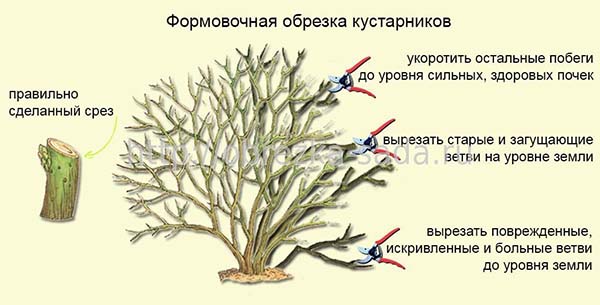
Form pruning ornamental shrubs
Anti-aging pruning
In order to get more abundant flowering and the ripening of a large number of fruits, on already aged plants, the rejuvenating pruning method is used. This method is also recommended for use on plants whose annual growth is less than 7 cm. This pruning method is characterized by activation of the growth of dormant or adnexal buds after the procedure for shortening old branches. The most optimal time for anti-aging pruning is the period from February to April, as well as from August to September.
Branches should be cut about 30% from the top, just after the plant has stopped flowering. Branches that show good lateral growth will become even more lush, and the number of fruits and flowering will increase if one of the three oldest in the bush is removed. This procedure is recommended to be performed every two years, which will not allow the plant to thicken too much and provide the necessary aeration.
Features of anti-aging pruning
Anti-aging pruning can also control the size of the inflorescences. So, in the case of a strong decrease in the length of the branches, the flowers will be larger than with a slight shortening. However, the concentration of flowering on a heavily pruned branch will also decrease. A number of ornamental shrubs, for example, coronal mock orange or action, with regular pruning, can lose the splendor of their crown, and selective shoots need to be reduced accordingly.
The pruning procedure should be subjected to no more than four buds at a time, which later form strong branches and can replace less popular shoots next year. The bush undergoes complete shortening of the branches only with a significant reduction in flowers, in most cases this is observed 3-4 years after planting.
Also, amateur gardeners need to know about distinctive features bushes that bloom on the branches of last year, for example, hawthorn, large-leaved hydrangea, forsythia, and on the shoots of this year: panicled hydrangea, Japanese spirea. In addition, there are a number of ornamental shrubs, the flowering of which in the spring is carried out on the branches of the previous year, and in the summer - already on the branches of the current year. Such plants include weigala and kerria.

When to do anti-aging pruning
Perform anti-aging pruning for more decorative and fruit bushes best in early spring. A signal of the need for this procedure is the appearance of weak shoots and the shrinking of branches. It should be shortened above the branches, located as close as possible to the base of the branch or in a place that is characterized by more powerful growth of the rejuvenated shoot.
Radical rejuvenation
In cases where the shrub has lost the ability to form not only strong branches, but also weaker and shorter ones, it is necessary to resort to a radical rejuvenation procedure. All branches must be cut at ground level, and in a situation where the plant was formed on a stock, cut at a height of 10-15 cm from the location of the graft. Only in this case, the kidneys are activated and will give a new rapid growth, since the volume of the root has remained at the same level. Then, after a season or two, depending on the level of growth of the shrub, it is necessary to remove weak and poorly located branches.
Video "Features of pruning ornamental shrubs"
Proper pruning of ornamental shrubs
How to cut a shrub correctly and not harm it is one of the most common questions that beginner gardeners have. The procedure for competent pruning is not very difficult if you follow the basic recommendations.
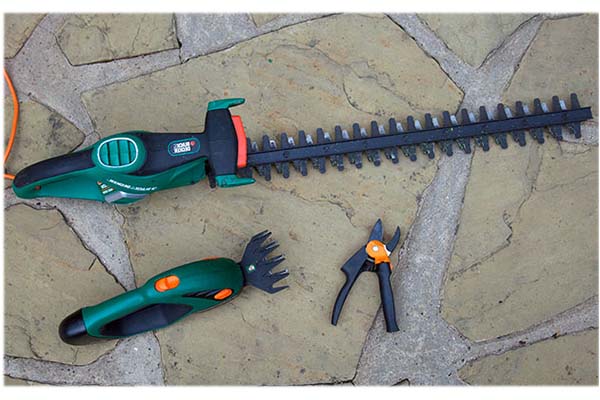
Pruning ornamental shrubs tools
During pruning, you must follow certain rules:
- all dried and broken shoots should be removed immediately;
- hemp and slices should not be split;
- the correct cut, which does not leave a hemp, is carried out at an angle, and not straight;
- the cutting tools used must be well sharpened and always clean;
- you should try to minimize the damage to the cultivated shrub: branches whose thickness is less than or equal to 2 cm are cut with a pruner, and in the case of thicker branches, with a hacksaw;
- in the process of work, it is necessary to act pointwise, try not to hook nearby shoots;
- to stimulate the growth of weak branches, shoots should be cut shorter, and for healthy and well-growing branches, too much shortening is not required;
- the correct cut is characterized smooth surface and without various scraps of bark. In case of an uneven cut, a garden knife can be used to achieve the desired smoothness;
- do not forget that it is better to pinch the shoot at one time than to cut it off later.
Also, do not forget about care after trimming: all sections are processed with garden pitch, and if the surface thickness is more than 3 cm, the use of oil paint will be much more effective.
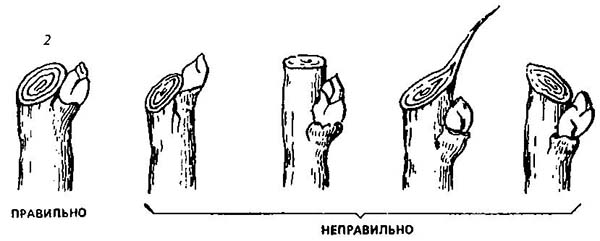
How to make a cut when trimming
Deren is a very fast-growing shrub, capable of constant watering and proper feeding give an increase of up to 1.5 meters.
Often, given plant pruned to form the desired crown shape. AT autumn period all old branches are removed, and in the spring strong vertical shoots will modify the bush. If the goal is to form a round and “shaggy” shrub, in the fall one-year growth should be shortened by several buds. In the spring, this pruning will strengthen the side branch.
Shrub cinquefoil initially has a uniform crown shape; accordingly, it undergoes a pruning procedure only when the plant is deformed.
With full growth, in the autumn, old and damaged branches are removed, and unrooted ones are cut a little.
Formative pruning should be carried out if you want to get more intense flowering. Anti-aging pruning is carried out, in most cases, after the hydrangea reaches 5 years of age.
Old branches are removed almost completely at ground level, it is enough to leave no more than 4-5 shoots. In the spring, from the buds located on the root collar, young flowering shoots, and the remaining old branches will bloom with renewed vigor.
In the case of removing already faded buds at a height of 30-40 cm from ground level, in spring it is possible to achieve an increase in young shoots on strong last year's branches, which will not allow long and flexible branches to bend under the weight of flower caps.
To obtain more blooming lush summer varieties of spirea, the pruning procedure should be carried out in the fall.
The length of the cut depends on the age of the plant:
- for shrubs whose age is more than 10 years, pruning is carried out at ground level. Next spring, new strong branches will appear from the root system, which will also bloom in the prescribed period of time;
- a younger shrub is recommended to thin out a little: old shoots are shortened by 25-30 cm. This pruning will increase the number of lateral buds in spring, which will change the appearance of the bush for the better.
After pruning, the plant should be mulched with a solution of humus or peat, and the roots should be covered from hypothermia.
Video "Pruning an ornamental shrub - spirea"
Organic top dressing after pruning
All plants after pruning should be fed. It doesn’t matter if the branch reduction procedure was performed in the spring or in the fall, only the fertilizers themselves are different.
Spring dressing play big role in the development of the plant, because it is during this period of time that the shrub increases its vegetative mass and restores everything that was lost during the winter. In addition, over time, the concentration nutrients gradually decreases in the ground.
First of all, it is necessary to supply the soil with nitrogen and potassium trace elements. For this, a solution of potassium nitrate is perfect and clean water, mixed in the following proportion: 3 tablespoons of fertilizer per 10 liters of water. Solutions of azofosk and nitrophoska and a mixture of 30 g of urea and 100 g of wood ash diluted with a bucket of water.
In the case of pruning a shrub in the period from August to September, the plant experiences an acute shortage of phosphate fertilizers, after all root system at this time is quite actively formed. For a more uniform achievement of shrub root fertilizers, top dressing should be evenly distributed around the perimeter of the near-stem circle, and the procedure for introducing useful microelements should be combined with watering.
For effective and full growth, decorative and fruit bushes it is recommended to fertilize with infusion. The finished composition will be formed after 2-3 days, and the best proportion is 0.5 kg of compost per 10 liters of water.
Watering the bush should be in the evening, when the heat has already subsided or in cloudy weather. It should not be allowed to get the solution on young branches and leaves, and in case of prolonged drought, trunk circle shrubs should be thoroughly soaked with plain water before using the compost mixture.
As a conclusion, it should be noted that pruning ornamental shrubs is not a complicated procedure and plays a significant role in the formation of healthy and beautiful plants, which will surely reward their owner with lush and beautiful flowering.
For a novice gardener, this problem is one of the most painful. How to cut? When to cut? How much to cut? There are so many plants, they are all so different ... At some point it may seem that you will never master this wisdom.
In fact, everything is not as difficult as it seems. After several years of gardening, you will intuitively begin to understand how the pruning of a plant depends on the time of its flowering, growth and branching characteristics.
Of course, experimenting for years is not necessary at all. You can open the book and find out everything at once. But here's the problem: we have a problem with good literature on this subject. One book will reasonably explain to you how to prune summer-blooming and spring-blooming spireas. From the other you will learn how to cut turf. But building a coherent and logical system on the basis of this fragmentary information is very difficult.
At one time, I bought up everything in a row books in Russian and English, on the covers of which it was written: "Trimming ..." And finally, I found what I was looking for. It was the English edition: `Successful Pruning`. I flipped through it, and everything somehow immediately fit into my head.
Today we offer you an adapted translation of this edition. Not the whole book, of course. But what seems to us the most important. We offer you a harmonious and intelligible, as it seems to us, system for trimming ornamental shrubs.
Actually, the whole system comes down to nine trimming techniques, which will be outlined below.
TECHNIQUE 1. CUT FOR SHAPE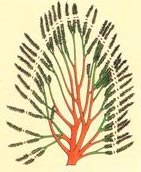
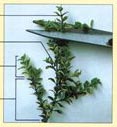 This technique is used for shrubs that are grown in molded hedges and require constant pruning.
This technique is used for shrubs that are grown in molded hedges and require constant pruning.
So: if you form a hedge in the spring, you only remove the growth previous year. If you prefer a haircut in the second half of summer, you delete, respectively, the growth of the current year. You may have to do both spring and summer pruning - if you are dealing with fast-growing plants. (Please note: we are talking about pruning shrubs that have already been formed for a hedge, having reached the desired height and dimensions).
Formative pruning will help you keep the plant neat and compact - in the desired size and shape. And remember: once you have applied this type of pruning, it is advisable to do the same every year.
Note: small plants can be cut with scissors or electric trimmer. For large ones, you need to use a pruner, as damaged leaves and stumps left from the shoots will turn brown and die.
(For more information on pruning hedges, see the articles on our website.)
According to technique 1, the following are cut: hedges of barberry, privet, hawthorn, honeysuckle, cotoneaster, snowberry.
Salix lantana is always recommended to trim using technique 1 to maintain its shape.
TECHNIQUE 2: REMOVING THE NEW GROWTH IN HALF
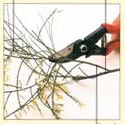 Do not let broom and other gorse bushes spread wide and expose the base. Cut new growth by half every year. Start doing this when the plant is still young. If a few years for pruning are missed, in the future, young shoots will grow, falling down from old coarsened branches, which will drastically reduce the decorative effect of the shrub. Trim off any new green shoots to encourage new branches and growth. Do not cut to old rough wood. Remove dead branches completely.
Do not let broom and other gorse bushes spread wide and expose the base. Cut new growth by half every year. Start doing this when the plant is still young. If a few years for pruning are missed, in the future, young shoots will grow, falling down from old coarsened branches, which will drastically reduce the decorative effect of the shrub. Trim off any new green shoots to encourage new branches and growth. Do not cut to old rough wood. Remove dead branches completely.
After pruning, the bush will look more elegant and compact.
Trim gorse-type shrubs after the flowers have faded but before the seeds have matured.
According to technique 2, they are cut: Russian broom, creeping broom, English gorse.
TECHNIQUE 3. CUTTING DEAD ENDS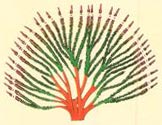
 Trim heathers and other similar plants, removing dead shoot tips with scissors. This will help the plant to be lean and compact and stimulate its flowering.
Trim heathers and other similar plants, removing dead shoot tips with scissors. This will help the plant to be lean and compact and stimulate its flowering.
As soon as the flowers begin to die off, remove them with scissors. With pruning fall-flowering heathers, wait until spring.
Remove shoots close to the base of the current year's growth. Do not cut to old dark wood.
By technique 3 they shave: heathers, almost all erics.
TECHNIQUE 4. SHORTENING SIDE BRANCHES![]()
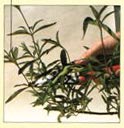 We are talking about shrubs that bloom on the shoots of the previous year. As a rule, these are summer-flowering shrubs. Pruning on such shrubs stimulates the growth of a large number of side branches and more abundant flowering. It is necessary to cut the shoots one third from the top to well-developed buds immediately after flowering. (Hydrangea paniculata can be pruned in early spring if you want to admire its powerful inflorescences in winter).
We are talking about shrubs that bloom on the shoots of the previous year. As a rule, these are summer-flowering shrubs. Pruning on such shrubs stimulates the growth of a large number of side branches and more abundant flowering. It is necessary to cut the shoots one third from the top to well-developed buds immediately after flowering. (Hydrangea paniculata can be pruned in early spring if you want to admire its powerful inflorescences in winter).
After pruning, the plant will not look significantly increased in growth compared to last year. But it will become more compact, and flowering next year will be more abundant.
According to technique 4, they are cut: hawthorns, panicled hydrangea, rose rugosa (if you grow it not for the sake of fruits, but for the sake of flowering), erica tree. The latter should be cut not by a third, but by two-thirds of the shoot.
TECHNIQUE 5. REMOVING ONE STEM OUT OF THREE.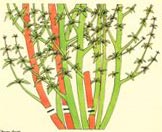 A large number of shrubs that produce many new shoots every year will look healthy and beautiful if you cut one shoot out of three each year. This very common technique avoids overcrowding and encourages flowering on strong shoots.
A large number of shrubs that produce many new shoots every year will look healthy and beautiful if you cut one shoot out of three each year. This very common technique avoids overcrowding and encourages flowering on strong shoots.
The technique is applied to three groups of bushes:
- Those that bloom early on the shoots of the previous year (forsythia, spiral vanguta, ornamental currants)
- Those that bloom profusely throughout almost the entire summer (shrub cinquefoil).
- To some shrubs that are grown for their beautiful foliage (white turf "Elegantissimo").
This type of pruning should begin when the shrub reaches the age of three. And if every year after that you cut one branch out of three, the shrub will look strong and compact at the same time.
Remove one stem out of three, cutting it as close to the ground as possible. First of all, choose the weakest and oldest branches.
After all old and weakened branches have been removed, remove those that extend far from the center of the bush and break the shape of the plant. If you do not see a bud near the ground from which a new shoot can come, leave a short stem with a bud. Subsequently, you can delete this branch as well, when there is enough new growth to replace it.
After pruning, the shrub may look somewhat sparse. But soon new shoots will appear that will fill the space.
According to technique 5, they are cut: a significant part of the shrubs, if they need to be formed as tapeworms, and not for a hedge. Among them are barberries, cotoneaster, hazel, action, white derain "Elegantissimo", colquitsia, honeysuckle, sea buckthorn, mahonia, weigela, snowberry, stephanandra tanaki, mock orange, goof, ornamental currants, forsythia, cinquefoil, lilacs (with a small caveat: remove you need not one of three, but one of four shoots), elderberry (if it is necessary to stimulate not the growth of foliage, but flowering and fruiting); spireas - arguta, vangut, thunberg, nipponika, Japanese - Bumalda and Shirobana, viburnum (if you want to keep the bush more compact).
Please note: shrubs that bloom in early spring should be cut only after they have faded. Summer flowering shrubs can be cut in early spring.
TECHNIQUE 6. CUT TO THE GROUND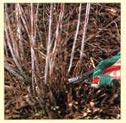 Use this technique to cultivate, improve the development of plants that throw out a large number of strong-growing twigs (such as sweet raspberries).
Use this technique to cultivate, improve the development of plants that throw out a large number of strong-growing twigs (such as sweet raspberries).
Some shrubs, such as ornamental raspberries, produce many new shoots each year. Old branches are best cut in early spring to ground level.
Such pruning is also used in cases where, in plants growing like raspberries, young shoots have decorative coloring. Let's say Rubus cockburnianus has young shoots. white color. With age, their color changes and becomes less interesting. It is advisable to cut such a plant annually to ground level.
When pruning such plants, you do not have to worry about making a cut on a bud that you can see. Young shoots will come directly from the ground.
According to technique 6, they are cut: decorative raspberries, stefanander inquis, bicolor lespedeza.
TECHNIQUE 7. CUT TO THE BASE OF THE BUSH (A)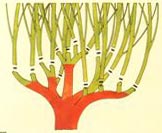 Plants that are grown for their beautifully colored shoots, such as Derain white, will have more attractive appearance, if they are regularly cut back 5 centimeters from the base of the bush to encourage the growth of new shoots.
Plants that are grown for their beautifully colored shoots, such as Derain white, will have more attractive appearance, if they are regularly cut back 5 centimeters from the base of the bush to encourage the growth of new shoots.
The same technique is necessary in order to stimulate the growth of large ornamental leaves, such as yellow-leaved elderberry.
Let the plant grow a season after planting, and then cut back the following spring to a height of 5-7 cm from the ground.
We do not recommend cutting plants in this way every year: if the shrub is not well fed or poorly mulched, it will only be able to throw out weakened thin stems. But pruning to the base every second year is just what you need. It will promote the growth of strong thick stems, and the plant will not need intensive feeding.
Technique 7 cuts: turf with decorative bark and decorative leaves, willows with decorative bark, elderberry - if it is grown for the sake of beautiful leaves.
TECHNIQUE 8. CUT TO THE BASE OF THE BUSH (B)
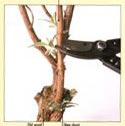 The technique is exactly the same as the previous one. But pruning should be done in the very first spring after planting and is required every year without fail. Buddleia and other shrubs that bloom on current season growth (such as Hydrangea arborescens) will produce larger flowers on more compact plants if you prune the plant 5-7 cm from the base each spring. If this is not done, the plants will produce smaller flowers on ankle-length, outstretched branches.
The technique is exactly the same as the previous one. But pruning should be done in the very first spring after planting and is required every year without fail. Buddleia and other shrubs that bloom on current season growth (such as Hydrangea arborescens) will produce larger flowers on more compact plants if you prune the plant 5-7 cm from the base each spring. If this is not done, the plants will produce smaller flowers on ankle-length, outstretched branches.
Cut off all last year's growth, leaving 2 buds at the base. This is usually 5-7 cm on last year's shoots.
If the bush has grown to a very large size and is full of shoots, cut one or two old stems to ground level. This will allow the plant to conserve energy for better flowering and get rid of poorly placed branches.
After pruning, many bushes can throw out shoots up to one and a half meters or more per season.
The same technique is applicable in the case of dwarf Japanese spireas. By cutting them to the base of the bush, you kill several birds with one stone: you create growth conditions for new strong stems, form a compact, beautifully shaped shrub, and in the case of yellow-leaved spireas, you promote the growth of brighter and more expressive foliage.
According to technique 8, they are cut: buddley, tree hydrangea, spirea "Little Princesses", "Golden Princesses", "Gold Mound", "Nana" and the like.
TECHNIQUE 9. CUTTING GRAY LEAVED PLANTS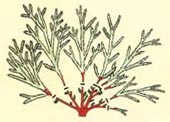
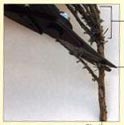 Regular pruning of plants such as lavender, perovski helps to create the correct compact form. Start cutting the plant while it is young. If you first resort to a strong pruning of an adult plant and cut into old wood, the shrub can be very weakened and even die. Prune regularly every spring.
Regular pruning of plants such as lavender, perovski helps to create the correct compact form. Start cutting the plant while it is young. If you first resort to a strong pruning of an adult plant and cut into old wood, the shrub can be very weakened and even die. Prune regularly every spring.
If the growth of the current year comes directly from the base of the bush, cut the plant 5-10 cm from the ground.
With a mature plant with a lignified base that does not have young shoots coming from the ground, be careful. Do not cut into old dark wood. Get by with pruning the previous year's soft shoots 5-10 cm from the old dark wood.
According to technique 9, they are cut: lavender, perovski.
Here, in fact, is all the wisdom.
Of course, this scheme needs to be approached creatively. If we plant a shrub, which is usually pruned using technique 5 (one out of three shoots is removed), has grown strongly, lost its attractive shape and began to bloom worse, it can be radically planted on a stump using technique 8 and thereby rejuvenate. If the tips of a shrub that is cut using the same technique 5 are frozen, you still have to not only remove one shoot out of three, but also walk with a pruner along the tips of the frozen branches. For example, I don’t really like it when my Goldfinger and Tangerine cinquefoils fall apart into somewhat shapeless bushes, and therefore every spring I cut them like gorse - half the growth of last year. In the same way, and with the same goals, I cut the summer-flowering spireas of Bumld and Shiroban. Or, for example, paniculate hydrangea. Sometimes you cut it not by a third of the shoot, but much more - in search of a good pair of buds and a beautiful shrub habit as a whole.
In short, it is quite acceptable to deviate from the rules if you know these rules well and perfectly understand why you are doing this or that movement with a pruner.
And finally: any pruning technique must be combined with sanitary pruning - remove all diseased, broken, crooked, weakened branches. But this is already quite simple ...
Good luck cutting!
Irina SAVVATEEVA, General Director of the Savvateev Nursery

